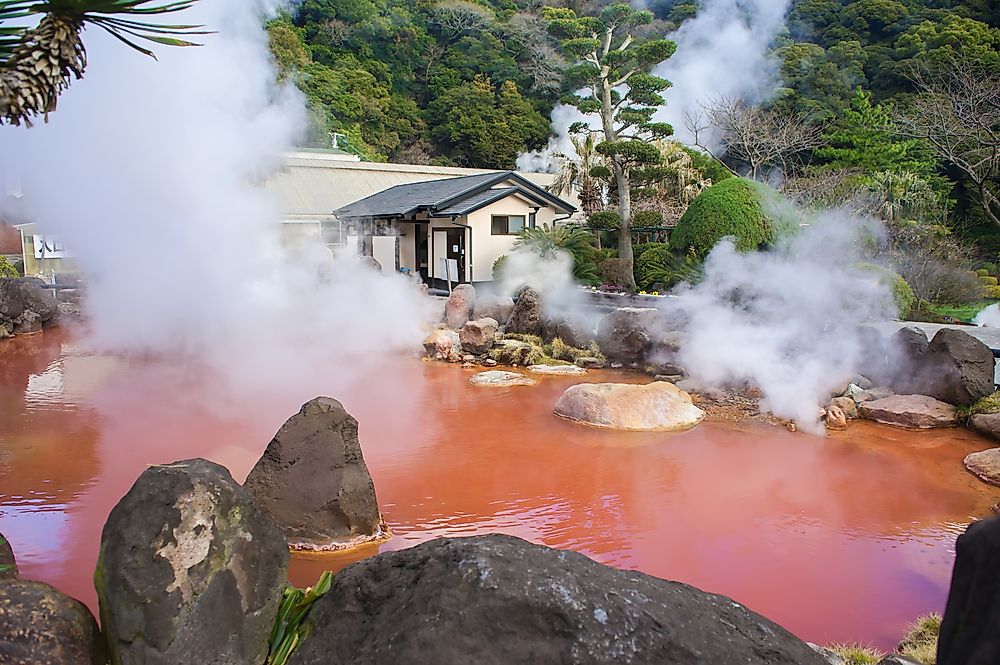The Nine Hells of Beppu - Unique Places Around the World

The Nine Hells of Beppu is a designated "Place of Scenic Beauty" and one of the top tourist destinations in Japan. Despite their name, the “hells” of Beppu are actually hot springs with unique features. These features are so unique, in fact, that the hot springs stand out in Japan, a country with thousands of hot springs!
The Beppu Hot Springs
The hot springs are located in Beppu which is situated in the island of Kyushu in southern Japan. Beppu Onsen, the group of hot springs in which the Nine Hells are found, is the second largest producer of geothermal water worldwide after Yellowstone National Park in the US. There are almost 3,000 hot springs within the city of Beppu.
Dubbed the Hells of Beppu due to the high temperatures they record, the hot springs remain relatively unknown outside of Japan. The hot springs in Beppu record high temperatures of water with some said to reach the boiling point of water. Due to this, visitors are not allowed to enter the hot springs as they can be harmed by the extremely hot water.
The Nine Hells of Beppu
Every hotspring is unique and has a different color due to the different minerals. Additionally, each hot spring has a distinct native folklore.
1. The first hell is Umi Jigoku or the Sea Hell. The pond was created over a millennium ago and is a beautiful cobalt blue color. The temperature of the pond is so hot that it stays at a rolling boil and can poach an egg. Tourists who want a taste of hell can purchase a pudding cooked within the waters.
2. The second hell, Oniishibou Jigoku or Shaven Head Hell, is a mud pool. The boiling temperatures of the water make mud bubbles at the surface. The pond is named for the resemblance of the mud bubbles to the hairless head of a Buddhist monk.
3. The Yama Jigoku or Mountain Hell, is the third hot spring. It was formed by a mud volcano that also made a small mountain with small ponds around it.
4. The Kamada Jigoku or Cooking Pot Hell, is the forth spring. It is a group of several bowling springs. A statue of the devil is perceived to be the chef. As these ponds are cooler than the other springs, tourists can drink the water and enjoy snacks cooked in the pond.
5. The fifth hell is a salt spring known as Oniyama Jigoku. The pond is known by Crocodile Hell as it is home to 100 crocodiles. The pond is also known as Demon Mountain Hell as the spring generates a lot of steam. The steam is said to be able to generate enough power to tug one and a half train cars!
6. The sixth hell, Shiraike Jigoku or White Pond Hell, is named for the white steam coming off the pond and blanketing the area. The waters are a milky white tinged with emerald from the sassolite minerals.
7. The seventh hell, Tatsumaki Jigoku or Spouting Hell, features a geyser that spouts every 30 minutes for about 10 minutes. The water can reach a height of 160 feet.
8. The eighth hell, Chinoike Jigoku or Blood Pond Hell, is named for the distinctive red water of the pond from the water's high iron content. It is one of the most stunning and photogenic ponds of the nine hells. The water has antiseptic properties, and tourists can dip their toes downstream or purchase a mud paste.
9. Kinryu Jigoku or Golden Dragon Hell, is the ninth hell. The pond is named for a dragon statue at the pond that looks as though it has come to life from steam rising from the pond coming out of it's nostrils. The rim of the pond also has a golden sheen.
Tourism to the Nine Hells of Beppu
In a bid to gain income, the residents of Beppu have set up spas and shops where visitors can even get chance to eat foods cooked by the hot springs. The shops have a wide range of foods to cater to the diverse tastes of visitors and students who go to Beppu’s international university. There is also a chance to learn about the rich history of Japan in the nearby museums. During peak times, the number of visitors frequenting the area can rise up to 60,000 people.











